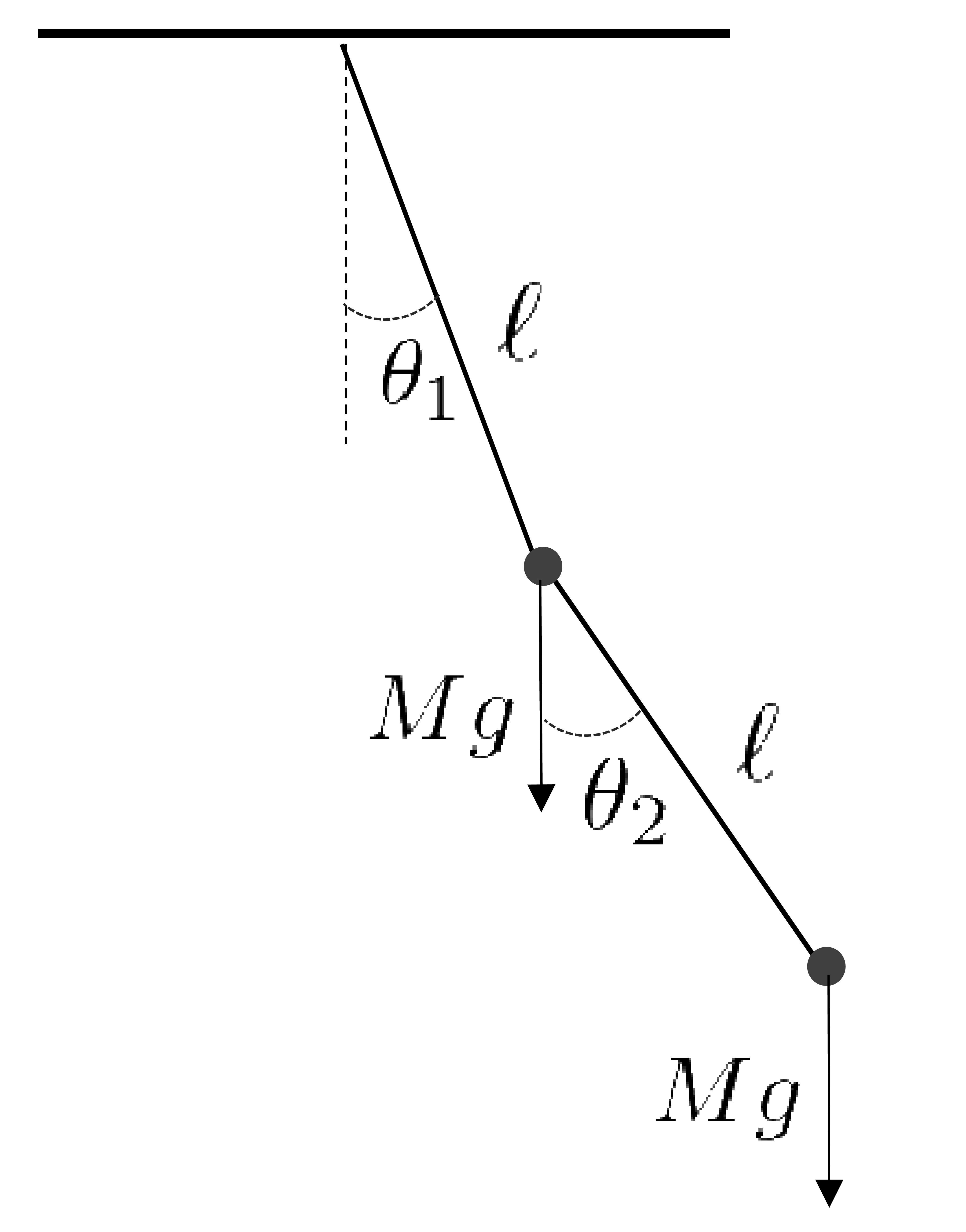1.経緯
放送大学の「物理と化学のための数学演習」という授業のレポートの課題のひとつに「二重振り子」があったので、忘れないようにここにメモっておきます。
2.レポート課題
天井から長さ \(\ell\) の紐で吊るされた質量 \(M\) の錘に、もう一つの同じ長さ \(\ell\) の紐で同じ質量の錘が垂れ下がった、二重振り子の微小振動を考える。この問題は自由度2の連成振動となっている。以下の問いに答えよ。
\(\textbf{[1]}\) それぞれの紐が鉛直線となす角度を \(\theta_1\,,\,\theta_2\,\)とし、近似式、\(\sin\theta\simeq\theta\,\)を用いて、2つの錘の運動方程式を導き、この連成振動の基準座標と基準振動数を求めよ。紐の質量は小さいとして無視する。
\(\textbf{[2]}\) 2つの紐を変形しない同じ質量 \(m\) の棒で置き換えるとどうなるか。棒の重心はその真ん中にあるとする。
※ 2. の問題は、私のやり方が拙かったせいか、解析解が得られませんでした。そこで、1. だけをここにメモります。
3.方程式の導出
 最初のオモリの座標を \((x_1,y_1)\,\) , そこから垂れ下がったオモリの座標を \((x_2,y_2)\,\) とする。
最初のオモリの座標を \((x_1,y_1)\,\) , そこから垂れ下がったオモリの座標を \((x_2,y_2)\,\) とする。
\(x_1=\ell\sin\theta_1\qquad y_1=-\ell\cos\theta_1\)
\(x_2=x_1+\ell\sin\theta_2=\ell(\sin\theta_1+\sin\theta_2)\)
\(y_2=y_1-\ell\cos\theta_2=-\ell(\cos\theta_1+\cos\theta_2)\)
\(\dot{x}_1=\ell\cos\theta_1\dot{\theta}_1\simeq\ell\dot{\theta}_1\)
\(|\dot{x}_1|^2=\ell^2\dot{\theta}_1^2\)
\(\dfrac{1}{2}|\dot{x}_1|^2=\dfrac{\ell^2}{2}\dot{\theta}_1^2\)
\(\dot{x}_2=\ell(\cos\theta_1\dot{\theta}_1+\cos\theta_2\dot{\theta}_2)\simeq\ell(\dot{\theta}_1+\dot{\theta}_2)\)
\(\dfrac{1}{2}|\dot{x}_2|^2=\dfrac{\ell^2}{2}(\dot{\theta}_1+\dot{\theta}_2)^2\)
\(\theta_1\,,\,\theta_2\,\)が小さいとするので、運動エネルギーは \(\quad T=\dfrac{M\ell^2}{2}\dot{\theta}_1^2+\dfrac{M\ell^2}{2}(\dot{\theta}_1+\dot{\theta}_2)^2\)
ポテンシャル・エネルギーは\(\quad U=-Mg\ell(\cos\theta_1+\cos\theta_1+\cos\theta_2)\)
よって、ラグラジアン\(\,L\,\)は
\(L=T-U=\dfrac{M\ell^2}{2}(2\dot{\theta}_1^2+2\dot{\theta}_1\dot{\theta}_2+\dot{\theta}^2)+Mg\ell(2\cos\theta_1+\cos\theta_2)\)
\(\dfrac{\partial L}{\partial\theta_1}\,=-2Mg\ell\sin\theta_1\simeq -2Mg\ell\theta_1\hspace{12mm}\dfrac{\partial L}{\partial\dot{\theta}_1}=M\ell^2(2\dot{\theta}_1+\dot{\theta}_2)\)
\(\dfrac{\partial L}{\partial\theta_2}\,=-Mg\ell\sin\theta_2\simeq -Mg\ell\theta_2\hspace{16mm}\dfrac{\partial L}{\partial\dot{\theta}_2}=M\ell^2(\dot{\theta}_1+\dot{\theta}_2)\)
オイラー・ラグランジュ方程式は\(\quad\dfrac{d}{dt}\left(\dfrac{\partial L}{\partial\dot{q}_1}\right)=\dfrac{\partial L}{\partial q}\,\,\)なので
\(2\ddot{\theta}_1+\ddot{\theta}=-2\dfrac{g}{\ell}\theta_1\qquad \ddot{\theta}_1+\ddot{\theta}_2=-\dfrac{g}{\ell}\theta_2\quad\)の関係が得られる。
これより
\(\left(\begin{array}{@{\,}c@{\,}}\ddot{\theta}_1\\[2pt] \ddot{\theta}_2\end{array}\right)=\dfrac{g}{\ell}\left(\begin{array}{@{\,}rr@{\,}}-2&1\\[2pt]2&-2\end{array}\right)\left(\begin{array}{@{\,}c@{\,}}\theta_1\\[2pt] \theta_2\end{array}\right)\qquad\)の連立微分方程式が導かれる。
\(\hspace{28mm}\)行列\(\,\,K\,\)
4.方程式の解法
この行列 \(K\) を対角化することで、方程式を解く。まず \(K\) の固有値と固有ベクトルを求める。
固有値 \(\lambda\) は、固有ベクトル \(\textbf{x}\) と \(K\textbf{x}=\lambda\textbf{x}\) の関係にあるので、\(\det{(K-\lambda I)}=0\) より
\(\lambda^2+4\lambda+2=0\qquad \lambda=-2\pm\sqrt{2}\qquad\)が得られる。
\(\textbf{(4-1)} \,\,\lambda_1=-2+\sqrt{2}\) のとき
\(\quad(K-\lambda_1 I)=\left(\begin{array}{@{\,}rr@{\,}}-\sqrt{2}&1\\[2pt]2&-\sqrt{2}\end{array}\right)\left(\begin{array}{@{\,}c@{\,}}x_1\\[2pt] x_2\end{array}\right)=0\qquad\) より
\(\quad x_1=\dfrac{1}{\sqrt{3}}\qquad x_2=\dfrac{\sqrt{2}}{\sqrt{3}}\qquad\quad \textbf{x}_1=\left(\begin{array}{@{\,}r@{\,}}\frac{1}{\sqrt{3}}\\[2pt]\frac{\sqrt{2}}{\sqrt{3}}\end{array}\right)\)
\(\textbf{(4-2)} \,\,\lambda_2=-2-\sqrt{2}\) のとき
\(\quad(K-\lambda_2 I)=\left(\begin{array}{@{\,}rr@{\,}}\sqrt{2}&1\\[2pt]2&\sqrt{2}\end{array}\right)\left(\begin{array}{@{\,}c@{\,}}x_1\\[2pt] x_2\end{array}\right)=0\qquad\) より
\(\quad x_1=\dfrac{1}{\sqrt{3}}\qquad x_2=-\dfrac{\sqrt{2}}{\sqrt{3}}\qquad\quad \textbf{x}_2=\left(\begin{array}{@{\,}r@{\,}}\frac{1}{\sqrt{3}}\\[2pt]-\frac{\sqrt{2}}{\sqrt{3}}\end{array}\right)\)
5.正則行列の逆行列
固有ベクトルを縦に並べた行列 \(P\) を用いて \(P^{-1}KP\) として \(K\) を対角化する。
\(\quad P=\left(\begin{array}{@{\,}rr@{\,}}\frac{1}{\sqrt{3}}&\frac{1}{\sqrt{3}}\\[3pt]\frac{\sqrt{2}}{\sqrt{3}}&-\frac{\sqrt{2}}{\sqrt{3}}\end{array}\right)\qquad\quad P^{-1}=\left(\begin{array}{@{\,}rr@{\,}}\frac{\sqrt{3}}{2}&\frac{\sqrt{3}}{2\sqrt{2}}\\[3pt]\frac{\sqrt{3}}{2}&-\frac{\sqrt{3}}{2\sqrt{2}}\end{array}\right)\)
この \(P^{-1}\) を用いて、新しい変数 \(\Theta_1\,\,,\,\,\Theta_2\,\,\)を定義する。
\(\quad\left(\begin{array}{@{\,}c@{\,}}\Theta_1\\[2pt] \Theta_2\end{array}\right)=P^{-1}\left(\begin{array}{@{\,}c@{\,}}\theta_1\\[2pt]\theta_2\end{array}\right)=\left(\begin{array}{@{\,}rr@{\,}}\frac{\sqrt{3}}{2}&\frac{\sqrt{3}}{2\sqrt{2}}\\[3pt]\frac{\sqrt{3}}{2}&-\frac{\sqrt{3}}{2\sqrt{2}}\end{array}\right)\left(\begin{array}{@{\,}c@{\,}}\theta_1\\[2pt]\theta_2\end{array}\right)\)
元の連立微分方程式は、変数 \(\Theta_1\,\,,\,\,\Theta_2$\,\,\)に対する以下の微分方程式と等価である。
\(\quad\dfrac{d}{dt}\left(\begin{array}{@{\,}c@{\,}}\Theta_1\\[2pt] \Theta_2\end{array}\right)=\dfrac{g}{\ell}\left(\begin{array}{@{\,}rr@{\,}}-2+\sqrt{2}&0\\[3pt]0&-2-\sqrt{2}\end{array}\right)\left(\begin{array}{@{\,}c@{\,}}\Theta_1\\[2pt] \Theta_2\end{array}\right)\)
最終的に、運動は2つの固有振動の足し合わせで表され、それぞれの固有振動数 \(\omega_1\,\,,\,\,\omega_2\,\,\)は、
\(\quad\omega_1=\sqrt{2+\sqrt{2}}\sqrt{\dfrac{g}{\ell}}\quad,\quad \omega_1=\sqrt{2-\sqrt{2}}\sqrt{\dfrac{g}{\ell}}\quad\) となる。
|
|
|
|
|